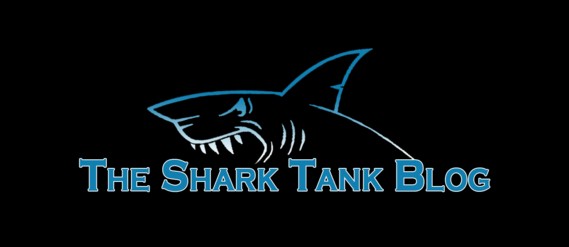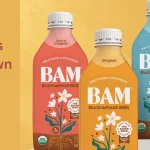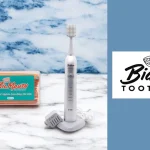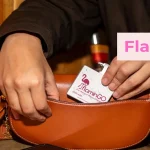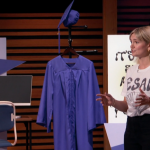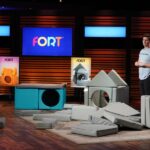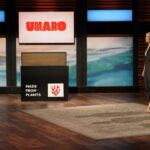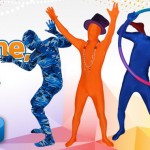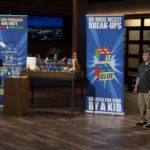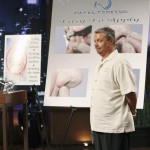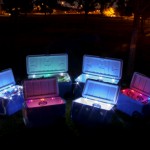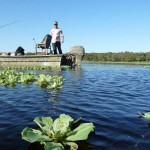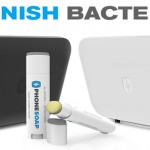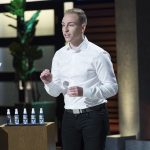Beyond the Tank Episode 108
 Beyond the Tank episode 108 aired June 3, 2016 and was the final installment of the show’s second season. Three past Shark Tank businesses get an in-depth, 20 minute segment on what’s happened since their original air date. Beyond the Tank episode 108 features Titin, a business Daymond invested in during season 6. We’ll also get a look at Andrea Hong, who Barbara calls “the best salesperson ever on the show,” and her business Q Flex. Barbara and Mark teamed up with a $25K investment for 25% of the business in season six. Robert invested $125K for 25% of the Natural Grip in season six and we’ll see how Ashley Drake is doing with the company since then.
Beyond the Tank episode 108 aired June 3, 2016 and was the final installment of the show’s second season. Three past Shark Tank businesses get an in-depth, 20 minute segment on what’s happened since their original air date. Beyond the Tank episode 108 features Titin, a business Daymond invested in during season 6. We’ll also get a look at Andrea Hong, who Barbara calls “the best salesperson ever on the show,” and her business Q Flex. Barbara and Mark teamed up with a $25K investment for 25% of the business in season six. Robert invested $125K for 25% of the Natural Grip in season six and we’ll see how Ashley Drake is doing with the company since then.
What have these companies been up to since first partnering with a Shark? Find out on Beyond the Tank!
Beyond the Tank Episode 108 Featured Sharks
- Investor – Daymond John
- Investor – Barbara Corcoran
- Investor – Robert Herjavec
Beyond the Tank Episode 108 Entrepreneurs
- Company – Q Flex
- Company – The Natural Grip
- Company – Titin
Beyond the Tank Episode 108 Recap
Titin
Patrick Whaley brought his workout gear, that he calls Titin, to the Shark Tank in season 6. The gear is weighted and form-fitting, to enhance workouts. Daymond John offered him $500,000 in return for 20% equity in the company. Patrick accepted and landed a Shark deal.
Daymond is excited about his investment. “A couple years ago, I was wearing the traditional weighted vest with the big metal plates in it, and after two weeks I had a double hernia. Patrick has weighted compression gear where the pads move with the body. It resonated with me.”
The initial impression only grew stronger when Daymond researched Titin. He was so impressed by the company and what Patrick had accomplished, he decided to change the deal. Instead of $500,000 for 20% of the company, he offered Patrick $1 million in return for 50%. Patrick agreed to the bigger bite, and Daymond became a full partner in the company. Titin is Daymond’s largest investment to date on Shark Tank.
“I am going to make it my goal to make this brand huge,” promised Daymond.
The strategy so far is working. When Titin appeared on Shark Tank, they were averaging $10,000 a month. In the seven months after the appearance, sales grew to $1 million a month.
Patrick has been meeting regularly with Daymond about strategy and sales, but Daymond has been pressuring him to actually move the operations to New York.
“I’ve never had an external company in my office,” says Daymond, but he’s determined to make Titin the first.
Patrick’s unsure about the move. He’s loyal to his team and unwilling to force a move that might mean losing some of his current staff. He brings it to a team meeting, to discuss pros and cons. Two of his main salespeople have just bought houses, and one is married and settled in the Atlanta area. Cost of living in New York is another challenge. The team agrees on a suggestion of creating a hub in their current location, and moving the main office to NY as Daymond wants. Patrick goes to NY to meet with Daymond and to discuss the possibilities.
Daymond has been wearing the Titin armor around the office, enjoying the benefits of using the product he’s heavily invested in. Patrick presents the idea of having a “hub” office and keeping his current team. Daymond explains that they already have sales, design, and production experts in place in the New York office. He encourages Patrick to make the move and to continue to grow Titin by taking advantage of the resources he has available. Daymond wants to create a gym within the building that athletes can use while wearing the Titin workout wear. Top athletes will be invited to try the product, and the workouts will be videotaped, allowing Patrick to work on the design and make improvements. Daymond introduces Patrick to a fitness model who has extensive social media resources. The move is looking more and more like a solid one for Titin.
“My goal,” says Daymond, “Is to make 20 different Titin compression gears, one for each sport, and that’s how we’re going to scale. That’s how we’re going to expand.”
Patrick is impressed with the resources Daymond offers, but he’s concerned about the future of his team. Daymond suggests making the current team “road salesmen,” sending them to conventions and other sales opportunities. The team would retain their jobs, but become more mobile. It’s a win-win for Titin and for Patrick. He decides to go forward with the move.
A month after the move Patrick is thrilled with the change. Some of his team have decided to stay in Atlanta and become mobile salespeople, while others joined Patrick in New York.
“I am ecstatic that Daymond believes in me,” says Patrick, “And I am looking forward to our future success.”
Q-Flex
Young inventor Andrea Cao, and her mother Hong Cao, came to the Shark Tank in season 6 with her invention, the Q-Flex. The device is intended to be a personal acupressure tool, allowing users to relieve tension and pain. When she appeared on the Shark Tank, 13-year-old Andrea had sold 800 of her Q-Flexes door to door. Barbara Corcoran and Mark Cuban offered her $25,000 in return for 25% equity in the company. Andrea accepted.
“When I met Andrea, I was blown away, as were all the other Sharks,” remembers Barbara. “Boy can she sell. She was extremely articulate. I think she was the best pitch we’d ever heard on Shark Tank.”
After her appearance on Shark Tank, Andrea has been able to sell 18,000 units, with 12,000 of those sales happening the night the episode aired. They’ve run into back-order problems, and are 500 orders behind, but catching up. Barbara has encouraged them to move into a fulfillment center, but the pressures of running the new and growing business have been overwhelming for the young entrepreneur.
With 50-100 e-mails coming in a day from customers looking for their late orders, Andrea decides it’s time for the company to move out of the garage and to seek out a fulfillment center. Mark Cuban has found them a fulfillment center in Dallas, but Andrea’s not sure if they should look for one locally or move. Barbara’s on her way to visit her young entrepreneur and her mom, so they hope to get her advice on the move.
Barbara’s goal is to move Q-Flex into the big retail stores. Mark has done the “heavy lifting” of building the website, but the distribution obstacles are causing hurdles to expansion. When the units come in, about 5% have to be sent back due to damage, adding a further delay to fulfilling back orders. Quality control is important to Andrea. They’re able to send out about 800 Q-Flexes per day, a number that’s not keeping up with demand. Barbara wants to talk about their numbers and sales, and whether the company is ready for big box stores.
They did $500,000 in sales in the first month, then $471,000, but in the next month, the sales dropped to $52,000, and then down to $8,000. The sales numbers are sinking like stones, a real problem. “You’re not advertising,” says Barbara, “And new sales are not coming in.”
Moving into the fulfillment center will reduce the shipping rates significantly, as well as greatly increase the flow of products out to the customers. Andrea tells Barbara she’d like to stay local, in order to stay on top of quality control. Barbara points out that they could visit the manufacturer, which is only an hour away, and check quality before the product is sent to the fulfillment center.
Before Barbara leaves, Andrea hands her checks repaying both her and Mark’s investments. The Shark partners will remain a part of the business, but Barbara is blown away by receiving a return on her investment so quickly.
The Hongs visit their manufacturer and discuss the possibility of on-site assembly and quality control, which will allow them to use the fulfillment center. The pair spend an afternoon calling local fulfillment centers, but find that the cost would be much lower through the Dallas location. They decide to go with Mark’s suggestion.
“There’s so much the Q-Flex can achieve,” says Andrea, “And I’m so happy that now we can actually go from being a hobby business to a real business. It’s a dream come true.”
The Natural Grip
Ashley Blake came to the Shark Tank in season 6 with her product, The Natural Grip. The product is custom-fitted to the user, and offers protection during strenuous exercise like pull-ups and push-ups. Robert Herjavec offered her an investment of $125,000 in return for 25% equity, saying “Every business I’ve invested in on Shark Tank that had a great operator has succeeded.”
“Ashley is definitely on the ball,” says Robert. “I like her level of intensity, and her level of discipline.”
Prior to the Shark Tank, Ashley had done $174,000 in sales. In a month after the appearance, sales reached $134,000, nearly a year’s worth of sales in a single month. In four months, they reached $310,000.
The Natural Grip is hand-made by a staff of 15 people. Ashley has made the decision to leave the Army and work on The Natural Grip full-time. She feels that, with her ability to fully dedicate herself to the company, she’ll be able to grow the sales and make the business a success.
Ashley meets with Robert to discuss the sales and the future of The Natural Grip. Robert tells Ashley that she’s not “spending any money on marketing,” and that needs to change. Ashley explains that trade shows are expensive. She sold $7,000 at a recent trade show, but it cost $5,000 to be there. Robert responds that trade shows aren’t a sales opportunity so much as a marketing opportunity. He’s concerned about Ashley.
“Ashley’s a lot more frantic today,” he observes. “When she was in the Tank, she seemed a lot more relaxed. I’m worried that she’s so hard on herself that she won’t be able to step back, and see the big picture, and move the company forward.”
The production capability is at 80,000, but sales are only at 30,000. Robert advises her to focus on sales, to bring the orders up to the potential for production. Ashley tells him about her decision to leave the Army and focus on the company full time. She’s feeling pressured, but Robert encourages her to get some perspective. He wants her to hire a sales manager and salespeople.
“I’m not discouraged,” says Robert. “The numbers to me, are very positive.” He tells her to not be so hard on herself.
She comes away from the meeting determined to hire salespeople. “It’s obvious that we just need to put a few things into place, and we can continue to go to the next level.”
A month later, Ashley has expanded her sales staff and increased her sales.
“The biggest lesson I’ve learned since appearing on Shark Tank is that this is a very long journey,” says Ashley. “You’re not going to be an instant success, and it’s going to take a lot of consistency and hard work to get there. But, the future of The Natural Grip is bright.”
It’s clear that Ashley, with Robert’s help, has gotten a grip on her business, and success is well in hand.

